Archive for Flowers
Beyond the Buzz: Creating a Bee-Friendly Garden That’s Also Beautiful
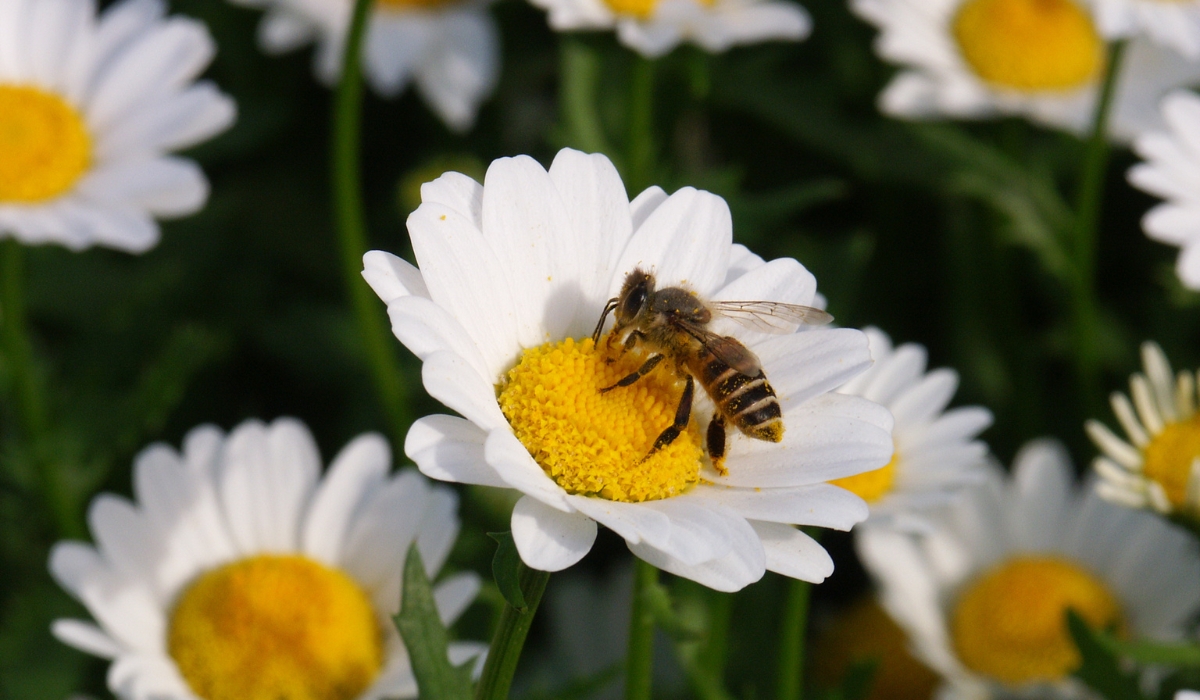
A garden teeming with life is a joy to behold, and the gentle buzzing of bees is a sure sign of a healthy ecosystem. But creating a bee-friendly garden isn’t just about helping our fuzzy, flying friends; it’s also about creating a vibrant, beautiful space for you and your family to enjoy. At DK Landscaping, we believe that you can have a garden that’s both a haven for pollinators and a stunning showcase of natural beauty.
Why Welcome Bees?
Bees are essential pollinators, responsible for much of the food we eat and the flowers we enjoy. By creating a bee-friendly garden, you are:
- Supporting Local Ecosystems: A healthy bee population is vital for the pollination of local plants, helping to maintain biodiversity in our community.
- Boosting Your Garden’s Health: More bees mean better pollination for your flowers and vegetable gardens, leading to more vibrant blooms and a more bountiful harvest.
- Creating a More Engaging Outdoor Space: A garden full of life is a garden full of interest. Watching bees flit from flower to flower is a simple pleasure that connects us with the natural world.
Designing Your Bee-Friendly Oasis
Creating a garden that bees will love is easier than you might think. Here are a few key principles to get you started:
- Plant in Patches: Bees are more attracted to large clusters of the same type of flower. Planting in patches of at least one square yard will make it easier for them to find and forage.
- Choose a Variety of Flowers: Different bees are active at different times of the year, so it’s important to have a variety of flowers that will bloom from early spring to late fall. This will provide a continuous source of food for our pollinating pals.
- Think in Color: Bees are most attracted to blue, purple, yellow, and white flowers. Incorporating these colors into your garden design is a sure way to catch their eye.
- Provide a Water Source: Bees need water to drink, but they can easily drown in open water. A shallow dish filled with pebbles or marbles and a small amount of water will give them a safe place to land and rehydrate.
Bee-utiful Plant Choices
Here are a few of our favorite bee-friendly plants that will also add a splash of color and beauty to your garden:
- Lavender: This fragrant herb is a bee magnet and its beautiful purple spikes will add a touch of elegance to any garden.
- Salvia: With a wide variety of colors and sizes, there’s a salvia for every garden. Their long-lasting blooms will keep the bees coming back for more.
- Sunflowers: These cheerful giants are not only a favorite of bees, but they also provide a tasty treat for birds and other wildlife.
- California Poppies: As our state flower, this vibrant orange beauty is a natural choice for any California garden and a favorite of local bees.
Ready to create a garden that’s buzzing with life? The team at DK Landscaping is here to help. We can design and install a beautiful, bee-friendly garden that you’ll love for years to come. Contact us today to learn more!
Pest Patrol: Organic Solutions for a Healthy May Garden
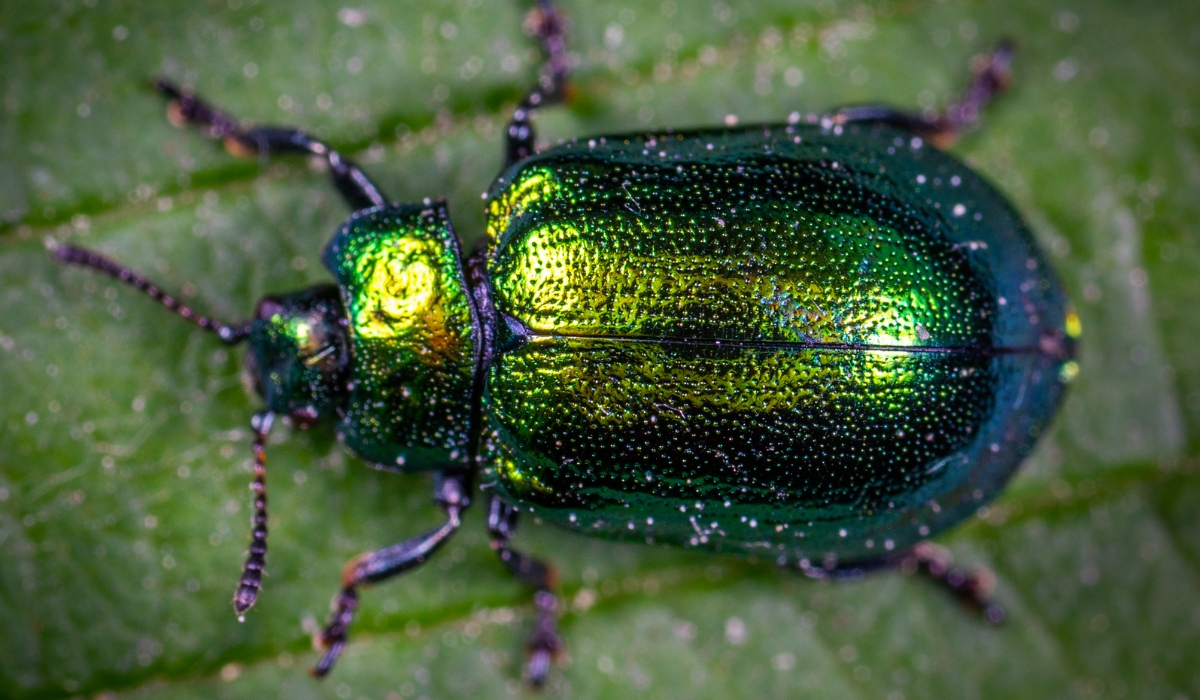
As May unfolds in California, bringing warmer weather and lush growth, it also signals the emergence of a familiar cast of characters: garden pests. Before you reach for harsh chemical sprays, consider the power of organic solutions! At DK Landscaping, we believe in nurturing a healthy ecosystem in your garden, which naturally deters pests without harming beneficial insects, pets, or your family. Here’s your guide to organic pest patrol this May.
Know Your Enemy: Identification is Key
Effective organic pest control starts with identifying the culprit. Are you seeing tiny, pear-shaped insects clustered on new growth (aphids)? Silvery trails on leaves (snails/slugs)? Chewed leaves with distinct holes (caterpillars or earwigs)? Or perhaps fine webbing on the undersides of leaves (spider mites)? A quick online search or a visit to your local nursery can help you pinpoint the pest and understand its lifecycle.
Prevention is the Best Defense
A strong, healthy plant is more resilient to pest attacks.
- Healthy Soil: Amend your soil with compost to foster robust plant growth.
- Right Plant, Right Place: Ensure plants are suited to your climate and sun exposure. Stressed plants are more susceptible to pests.
- Good Air Circulation: Prune overcrowded plants to improve airflow, discouraging fungal issues that can weaken plants and make them pest-prone.
- Attract Beneficials: Plant flowers like dill, fennel, yarrow, and cosmos to attract ladybugs, lacewings, and parasitic wasps, which are natural predators of many common pests.
- Regular Scouting: Inspect your plants frequently, especially new growth and the undersides of leaves. Early detection makes treatment much easier.
Targeted Organic Treatments
Once identified, here are some gentle, yet effective, organic treatment methods:
- Hand-Picking: For larger pests like snails, slugs, or caterpillars, simply hand-pick them off your plants and drop them into a bucket of soapy water. Do this in the early morning or evening when they are most active.
- Strong Water Spray: A forceful spray of water can dislodge aphids, spider mites, and whiteflies from plant foliage. Repeat every few days until the population is controlled.
- Insecticidal Soap: For soft-bodied insects like aphids, mealybugs, and spider mites, insecticidal soap is a great option. It works by disrupting their cell membranes. Ensure thorough coverage, especially on the undersides of leaves. Always follow product instructions carefully.
- Neem Oil: Derived from the neem tree, this natural insecticide acts as an anti-feedant and growth disruptor for a wide range of pests. It’s effective against aphids, spider mites, whiteflies, and more. Apply as directed, typically in the cooler parts of the day.
- Diatomaceous Earth (DE): For crawling insects like slugs, snails, and earwigs, a barrier of food-grade DE around plants can be effective. It works by abrading their exoskeletons, causing dehydration. Apply when dry and reapply after rain.
By adopting these organic pest patrol strategies, you’re not just tackling immediate problems; you’re cultivating a resilient, vibrant garden that works in harmony with nature. For expert advice on maintaining a healthy, pest-free landscape, contact DK Landscaping – we’re dedicated to sustainable beauty.
Designing Your Dream Spring Garden: Inspiration from DK Landscaping for March
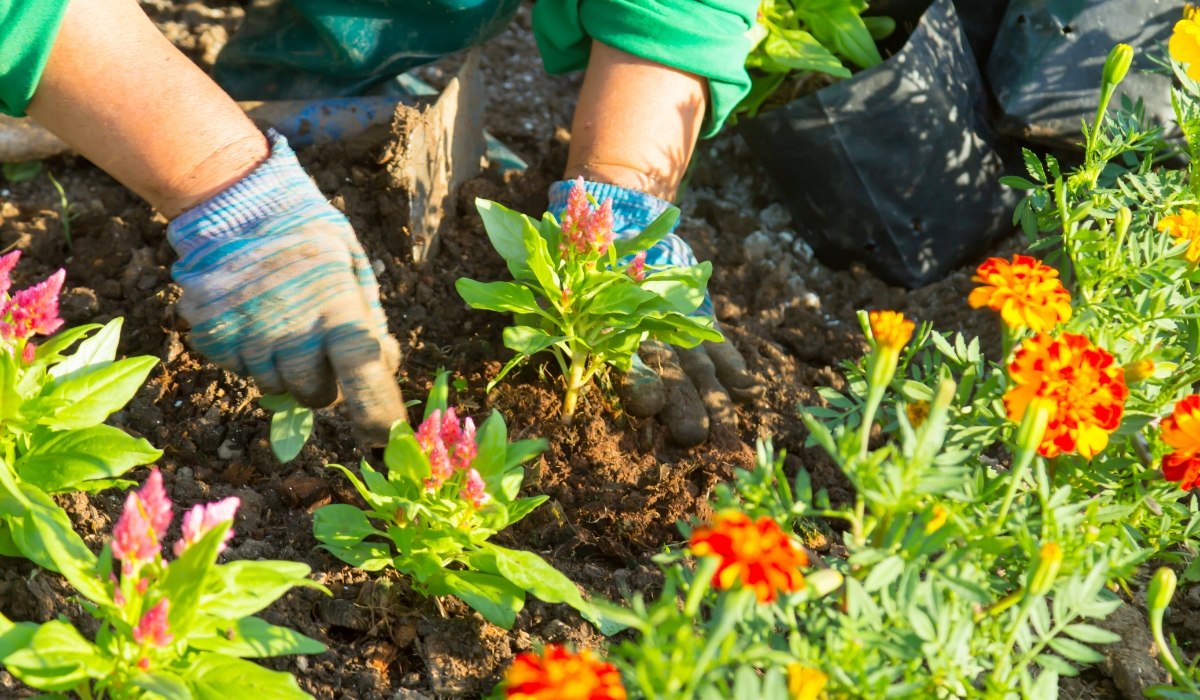
As the landscape awakens in March, it’s the perfect time to not only tend to essential gardening tasks but also to dream and design the spring garden you’ve always envisioned. At DK Landscaping, we believe that thoughtful planning and creative inspiration are key to creating outdoor spaces that bring joy and beauty throughout the season.
This March, let’s explore some inspiring ideas and design considerations to help you craft your dream spring garden, with guidance and inspiration from the experts at DK Landscaping.
Embracing Color and Fragrance:
- Layering Spring Blooms: Create a tapestry of color by layering different spring-blooming plants with varying heights and bloom times. Start with early bloomers like daffodils and tulips, followed by mid-season favorites like irises and peonies, and then late-spring beauties like roses and foxgloves.
- Adding Fragrant Flowers: Engage your senses by incorporating fragrant spring blooms such as lilacs, hyacinths, sweet peas, and stock. Place them near walkways, patios, or windows where their delightful scents can be easily enjoyed.
- Creating Themed Color Palettes: Consider designing specific garden areas with a cohesive color palette. For example, a serene blue and white garden with forget-me-nots, white tulips, and bluebells, or a vibrant warm-toned bed with red poppies, orange calendula, and yellow daffodils.
Designing for Structure and Flow:
- Defining Garden Beds and Borders: Create clear definition between your lawn, pathways, and planting beds using edging materials like stone, brick, or metal. This adds a sense of order and visual appeal to your garden.
- Incorporating Vertical Elements: Add height and visual interest by incorporating vertical elements such as climbing roses on trellises, clematis vines on arbors, or tall flowering spires like delphiniums and snapdragons.
- Creating Pathways and Focal Points: Design inviting pathways that encourage exploration of your garden. Create focal points with striking plants, unique sculptures, or charming water features to draw the eye and add personality.
Considering Functionality and Enjoyment:
- Designing Outdoor Living Spaces: Extend your living space outdoors by creating comfortable seating areas, dining nooks, or even an outdoor kitchen. Consider the placement of these areas in relation to sunlight, shade, and prevailing winds.
- Attracting Pollinators: Design your garden with pollinators in mind by including a variety of nectar-rich flowers that attract bees, butterflies, and hummingbirds. Include native plants whenever possible.
- Creating a Cutting Garden: If you enjoy bringing fresh flowers indoors, dedicate a section of your garden to growing cut flowers like zinnias, cosmos, sunflowers, and dahlias.
Getting Started with Your Spring Garden Design:
- Assess Your Existing Space: Take a good look at your current garden, noting sunlight patterns, soil conditions, and existing plants.
- Gather Inspiration: Browse gardening books, magazines, websites, and social media platforms for ideas and inspiration that resonate with your style and local climate.
- Sketch Your Ideas: Create a rough sketch of your desired garden layout, noting the placement of different plants and features.
- Consult with the Experts: If you need help bringing your spring garden vision to life, the design team at DK Landscaping is here to provide expert advice and create a customized plan for your outdoor space.
Let DK Landscaping help you design and cultivate the spring garden of your dreams this March!
Contact us today for a consultation and let’s bring your vision to full bloom.
Spring Awakening: Essential March Gardening Tasks with DK Landscaping
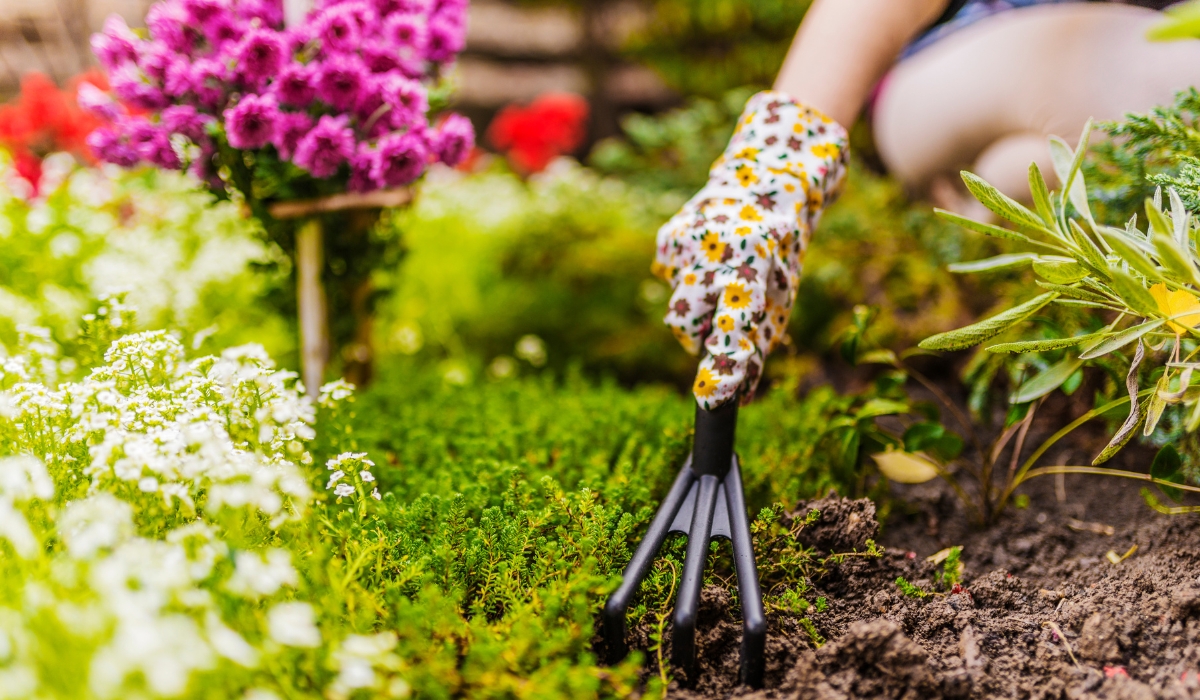
Ah, March! The air is alive with the promise of new beginnings, the days are noticeably longer, and a vibrant energy returns to our California landscapes. At DK Landscaping, we eagerly anticipate this time of year, as it marks the true awakening of our gardens.
March is a bustling month for gardeners, filled with exciting opportunities to nurture new growth, plant for the season ahead, and revitalize our outdoor spaces after the quieter winter months. Let’s dive into some essential March gardening tasks to ensure your landscape flourishes this spring and beyond, courtesy of your friends at DK Landscaping.
Embracing the Burst of New Growth:
- Fertilizing for Spring Vigor: As plants emerge from dormancy and begin their active growth cycle, they benefit from a boost of nutrients. Apply a balanced, slow-release fertilizer to your lawns, trees, shrubs, and flower beds. Follow the product instructions carefully.
- Spring Pruning (Selective): Now that spring-flowering shrubs like azaleas, rhododendrons, and lilacs have finished their bloom (or are just finishing), it’s the ideal time to prune them. Prune to shape, remove dead or crossing branches, and encourage bushier growth for next year’s floral display. Avoid heavy pruning now, as you could remove developing flower buds.
- Dividing Perennials: Many perennials that have become overcrowded can be divided in early spring. This rejuvenates the plants, encourages more blooms, and allows you to expand your garden or share with friends. Look for plants with multiple crowns that can be easily separated.
Planting for a Colorful Season:
- Planting Warm-Season Vegetables: With the soil warming up, March is the perfect time to start planting many of your favorite warm-season vegetables, such as tomatoes, peppers, eggplants, zucchini, and cucumbers. Be sure to check your local frost dates and protect young plants if unexpected cold snaps occur.
- Direct Sowing Annual Flower Seeds: Sow seeds directly into your garden beds for a continuous display of colorful annual flowers like zinnias, cosmos, marigolds, and sunflowers. Choose varieties that thrive in your local climate and soil conditions.
- Planting Summer-Blooming Bulbs & Tubers: Get a head start on summer beauty by planting bulbs and tubers like gladiolus, dahlias, lilies, and cannas in March.
Lawn Care for a Lush Carpet:
- Lawn Aeration: If your lawn experienced heavy foot traffic or the soil feels compacted, consider aerating it in early March. Aeration improves air circulation, water penetration, and nutrient uptake, leading to a healthier and greener lawn.
- First Mowing & Edging: As your lawn begins to actively grow, it’s time for the first mowing of the season. Set your mower blades to a higher setting for the initial cut and maintain a consistent mowing schedule. Don’t forget to edge along walkways and garden beds for a crisp, clean look.
- Weed Control & Overseeding (if needed): Address any winter weeds that have emerged in your lawn. If your lawn is thin or patchy, early March is a good time to overseed with a suitable grass seed variety.
Ongoing Garden Maintenance:
- Continue Weed Control: Stay vigilant with weed control throughout March. Young weeds are easier to remove than established ones.
- Monitor for Pests & Diseases: As new growth emerges, keep an eye out for any signs of early pest infestations or diseases. Addressing problems promptly can prevent them from spreading.
- Watering as Needed: While spring rains are common, monitor soil moisture levels and water deeply when necessary, especially for newly planted items.
Embrace the Energy of Spring with DK Landscaping:
March is an exciting time to be a gardener in California, and DK Landscaping is here to help you make the most of this vibrant season. Whether you need assistance with spring planting, pruning, lawn care, or designing a stunning spring landscape, our experienced team is ready to bring your vision to life.
Contact DK Landscaping today to discuss your March gardening needs and let us help your garden thrive!
End-of-Year Garden Review & New Beginnings with DK Landscaping

As the year draws to a close, it’s a natural time for reflection and planning. At DK Landscaping, we encourage you to take a moment to review your garden’s journey over the past year and look ahead to exciting new possibilities in the coming year. December offers a unique opportunity to assess what thrived, what struggled, and what changes you might want to make to create your dream California landscape.
Reflecting on Your Garden’s Year
- What Were the Highlights? Think back to the moments of joy your garden brought you. Were there specific plants that bloomed beautifully? Did you enjoy spending more time in a particular area? Identify these successes to build upon them.
- What Were the Challenges? Consider any challenges your garden faced, such as pest problems, water issues, or plants that didn’t perform as expected. Understanding these challenges will help you make informed decisions for the future.
- What Did You Learn? Every season in the garden teaches us something new. Did you discover a new favorite plant? Did you learn a better watering technique? Take note of these lessons.
December: A Time for Assessment and Planning
- Take a Garden Walk: Spend some time walking through your landscape, observing its current state. Note areas that might need attention in the coming months.
- Soil Testing: If you haven’t done so recently, consider performing a soil test. This will give you valuable insights into your soil’s nutrient levels and pH, helping you make informed decisions about fertilization in the spring.
- Sketch Out Ideas: Grab a notebook and sketch out any ideas you have for changes or additions to your landscape in the new year. This could include new planting beds, hardscape features, or changes in plant selections.
- Browse Inspiration: Look through gardening magazines, websites, and social media for inspiration and new ideas that resonate with your style and local climate.
Preparing for a Fresh Start
- Tool Maintenance: Now is a great time to clean, sharpen, and organize your gardening tools. Being prepared with well-maintained equipment will make spring tasks much easier.
- Seed Catalogs & Plant Research: Start browsing seed catalogs and researching new plants you might want to incorporate into your garden next year. Consider factors like sunlight requirements, water needs, and bloom times.
- Plan Your Spring Projects: If you have larger landscaping projects in mind, such as installing a new patio or renovating a planting bed, now is a good time to start planning and potentially get quotes from contractors like DK Landscaping.
Looking Ahead with DK Landscaping
As you plan for the future of your California landscape, remember that DK Landscaping is here to help. Whether you need assistance with design, installation, maintenance, or simply want expert advice, our team is dedicated to bringing your garden dreams to life.
Let us partner with you to make the coming year your garden’s best year yet! Contact DK Landscaping to discuss your landscaping goals for the new year.
Fall in Love with Your Landscape (Again!): November Tips from DK Landscaping
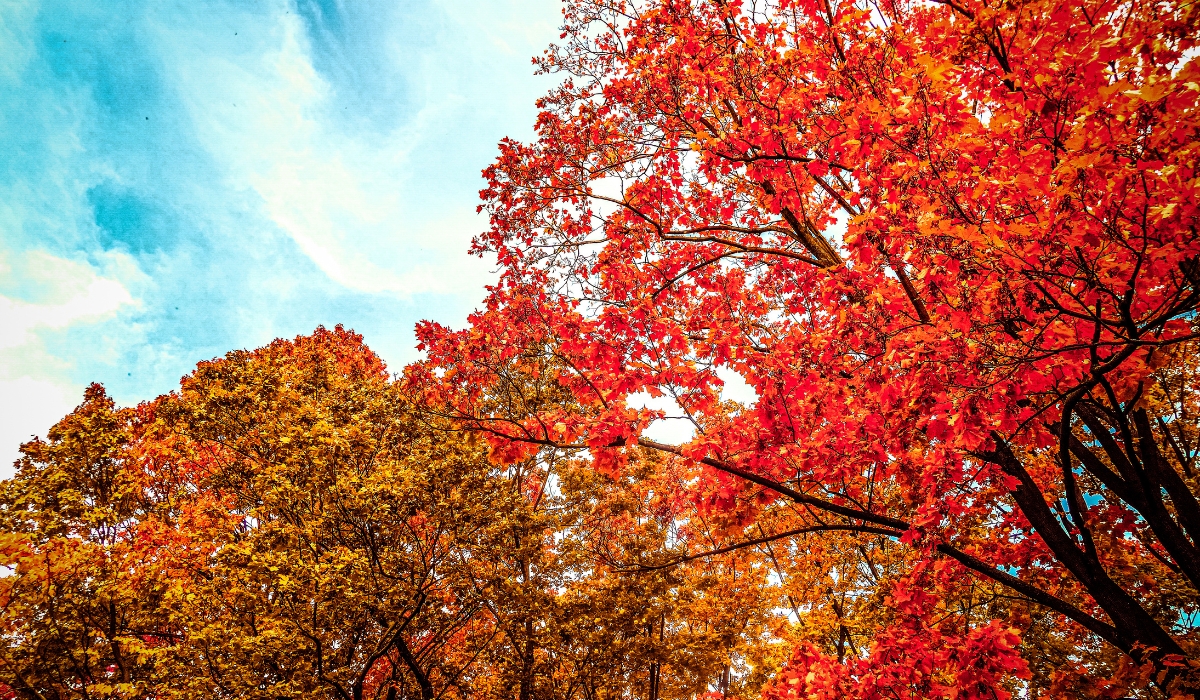
The air is getting crisper, the leaves are putting on their final, fiery show (though maybe with a little less intensity than our East Coast cousins!), and the scent of pumpkin spice is everywhere. Here in California, November marks a beautiful transition in our landscapes. While the scorching summer heat is a distant memory, it’s not quite time to huddle indoors just yet. In fact, November is a prime time to give your garden some much-needed attention and set it up for a thriving spring.
At DK Landscaping, we believe a well-maintained landscape is a year-round source of joy. So, grab a warm beverage, pull on your gardening gloves, and let’s dive into our top tips for making the most of your California garden this November!
Embrace the Post-Summer Refresh:
Summer can be tough on our plants. Now is the perfect time to assess the damage and give them some TLC:
- Deep Clean & Clear Out: Just like you might do a fall cleaning indoors, your garden needs one too! Rake up fallen leaves (they make great compost!), remove dead or diseased plant material, and clear out any lingering weeds that thrived during the warmer months. This helps prevent pests and diseases from overwintering in your garden.
- Pruning Power: Many shrubs and trees benefit from late fall pruning. Removing dead, damaged, or crossing branches improves air circulation and encourages healthy growth in the spring. Not sure where to start? Our experienced team at DK Landscaping can provide expert pruning services to ensure your plants are shaped and cared for correctly.
- Soil Love: After a long growing season, your soil might be depleted. Now is an excellent time to amend your soil with compost or other organic matter. This will improve drainage, aeration, and provide essential nutrients for the months ahead.
Watering Wisdom for Cooler Days:
While the temperatures are dropping, your plants still need water, just not as frequently as in the summer.
- Adjust Your Irrigation: Reduce your watering frequency and duration. Overwatering in cooler weather can lead to root rot. Observe your plants and the soil moisture levels to determine the right schedule.
- Water Deeply and Less Often: When you do water, water deeply to encourage strong root growth.
- Consider Rainfall: Keep an eye on the forecast! If we get a good amount of rain, you can likely skip a watering cycle.
Planting for the Future:
Believe it or not, November is a fantastic time for certain types of planting in California:
- California Natives: Many California native plants thrive when planted in the fall. The cooler, wetter conditions allow their roots to establish before the heat of summer arrives. Consider adding some beautiful and drought-tolerant natives to your landscape.
- Cool-Season Vegetables: If you enjoy fresh produce, now is the time to plant cool-season vegetables like lettuce, spinach, kale, broccoli, and garlic.
- Spring-Blooming Bulbs: Dreaming of vibrant tulips, daffodils, and hyacinths in the spring? Now is the time to plant those bulbs! They need the cool winter months to develop properly.
Don’t Forget the Details:
- Clean Your Tools: Before storing your gardening tools for the winter, clean and sharpen them. This will keep them in good condition and ready for action in the spring.
- Protect Tender Plants: If you have any frost-sensitive plants, consider moving them indoors or providing some form of protection on colder nights.
- Enjoy Your Space! Even with the cooler weather, take some time to appreciate the beauty of your fall landscape. It’s a different kind of beauty, but just as rewarding.
Ready to Give Your Landscape Some November Love?
At DK Landscaping, we’re passionate about helping you create and maintain a beautiful and healthy outdoor space year-round. Whether you need help with fall cleanup, pruning, planting, or simply want some expert advice, our team is here for you.
Contact DK Landscaping today for a consultation and let us help you fall in love with your landscape all over again this November!
Fall Landscaping Prep: Preparing Your California Yard for the Changing Season
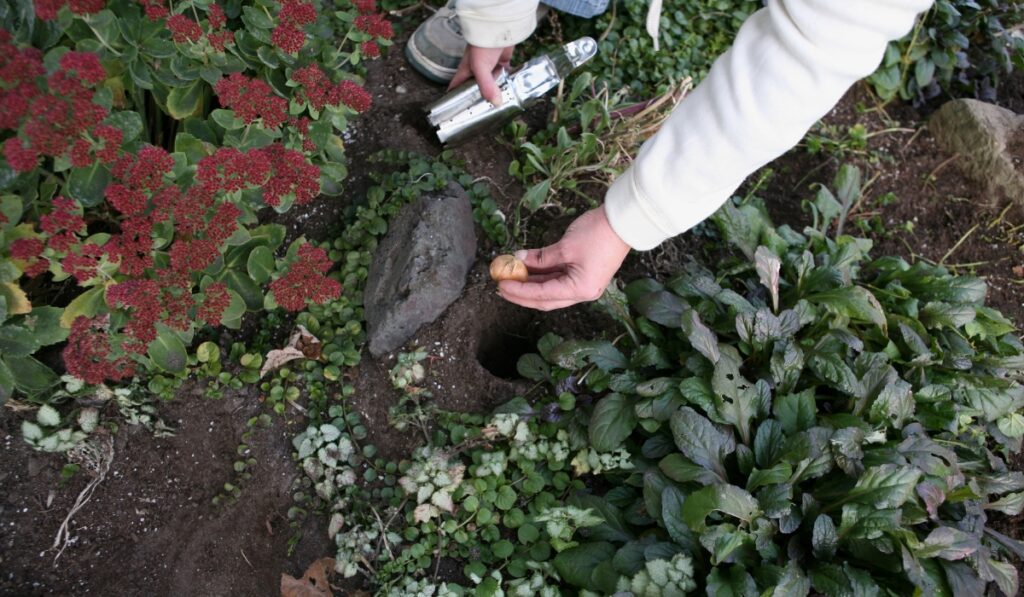
As the summer sun begins to soften and the days grow shorter, it’s time to shift our focus to fall landscaping preparation. At DK Landscaping, we understand the importance of transitioning your yard smoothly into the cooler months, ensuring a healthy and beautiful landscape that thrives through winter and bursts with life come spring.
Cleaning Up Summer Debris
The first step in fall landscaping prep is a thorough cleanup. Remove any fallen leaves, spent flowers, and debris from your yard. This not only tidies up the space but also helps prevent pests and diseases from overwintering. Pay close attention to areas around trees and shrubs, where fallen leaves can accumulate and create a damp environment that encourages fungal growth.
Preparing Soil for Fall Planting
Fall is the perfect time to revitalize your soil and prepare it for new plantings. Incorporate organic matter like compost or well-rotted manure into your garden beds. This improves soil structure, drainage, and nutrient content, providing a nourishing environment for your plants to establish strong roots.
Protecting Plants from Early Frosts
While California enjoys relatively mild winters, early frosts can still occur, especially in inland areas. Take preventative measures to protect sensitive plants:
- Covering: Use frost blankets or burlap to cover tender plants during cold nights.
- Mulching: Apply a thick layer of mulch around the base of plants to insulate the roots and protect them from freezing temperatures.
- Moving Container Plants: Bring potted plants indoors or to a sheltered location to shield them from frost.
Additional Fall Landscaping Tips
- Lawn Care: Aerate your lawn to improve drainage and reduce compaction. Overseeding can help thicken thin or bare spots.
- Pruning: Prune summer-flowering shrubs and trees after they finish blooming to encourage new growth in the spring.
- Irrigation: Adjust your watering schedule to accommodate cooler temperatures and reduced plant needs.
- Pest and Disease Control: Monitor your plants for signs of pests and diseases, and take action as needed.
DK Landscaping: Your Partner in Fall Landscape Preparation
Preparing your landscape for fall can be a daunting task, but DK Landscaping is here to help. Our team of experienced professionals can assist with everything from debris removal and soil preparation to plant protection and winterization. We’ll ensure your yard is ready to face the changing seasons and emerge healthy and vibrant in the spring.
Contact us today for a free consultation and let’s get your landscape ready for a beautiful fall and winter.
Remember, fall is a time of transition and renewal in the garden. By taking the necessary steps to prepare your landscape now, you’ll set the stage for a thriving and beautiful garden in the seasons to come.
3 Simple Flower Bed Ideas to Reduce Maintenance Costs
Adding a flower bed to your front or back yard is a smart and quick way to add color and liven things up. However, flower beds require a lot of maintenance and upkeep after the garden is installed. Here are a few tips to add some personality to your lawn and reduce the maintenance costs.
- Design the Perfect Shape for your Flower Bed

Beauty is in the eye of the beholder. Once you’ve decided on where to plant your new flower bed, the next step is to figure out what shape you’d like to have. There are tons of forms you can choose from. However, a bed with sharp angles can be challenging to cut and maintain because it’ll be hard to cut with a lawnmower. Granted, you can tackle those angles with a weed whacker, but that will be additional work on your end. Avoid extra work by designing and constructing flower bed ideas that have gradual and smooth curves.
- Install Weed Prevention Measures
The most common weed prevention method is landscape fabric. The fabric restricts weeds from growing through. However, weed roots can grow down through the material if the weed seeds germinate above the landscape fabric layer. Adding an extra layer of mulch will provide a strong defense against weeds and keep your flower beds healthy. A practical flower bed idea is laying down the fabric before planting and making X pattern slits where you want to plant your flowers. This simple method will keep the weeds at bay.
- Select the Overall Theme
There are two types of flower bed ideas, namely:
Formal flower beds – Here, the flowers are usually limited to a few different types. These beds typically have more geometric shapes and straight lines. They often include shrubs and yews that are planted in straight lines to form a border and create designs.
Informal flower beds – Here, you’ll find many different sizes, textures, and colors of flowers. These flower beds have some structure to the design, but the lines and borders are not as defined. The plants and flowers are left to grow as they wish with a little pruning here and there to promote new growth and maintain their size.
Flower beds are mostly used as beautiful masterpieces on the lawns of many homes. However, maintaining a flower bed can be time consuming and exhausting. Contact lawn and bed experts to receive a comprehensive range of lawn care and landscaping needs tailor-made for your flower bed ideas.
11 Flower Bed Ideas for a Truly Modern Home
A smattering of flowers and plants can give your outdoor space a springtime feel, especially during warmer summer months. Similarly, the pops of color and texture exhibited by flower beds can easily shake off the winter dullness from your home. This list of 11 flower bed ideas can help you transform your yard into a luxurious nature park.

1: Combining Tulips with Perennials and Annuals
Combining tulips with perennials and annuals creates a harmonious arrangement that comes back each year with little maintenance. Just space out your flowers to ensure that the tulips stand taller than the shorter, low-growing perennials and annuals. Typically, your tulips will return every year when winters are colder. There are multiple color choices to pick from, including white and black tulips. Overall, planting clear, primary tulips creates a festive effect in any mixed flower bed. Some companion options for a full flower bed include Daylily, Catnip, Bells of Ireland, and Salvia.
2: Side Yard Flower Bed for Tiny Spaces
You can leverage your sidewalk by planting pretty bizzy lizzies in a beautiful flower box and around the edge of a foundation bed. To bring out an inviting look, contrast their pink and white blossoms with deep green hosta lilies. Although hosta lilies are commonly planted for their foliage, they also bear tiny white, lavender, or violet flowers.
3: Reconditioned Tree Stump Flower Bed
If you have old tree stumps within your yard, why not use them for a flower bed instead of digging them out? Add a pelargonium in the center and surround it with deep purple bellflowers and gold and orange nasturtium with variegated leaves. Additionally, plant some bellflowers, ornamental grass, and pelargonium around the roots for an excellent balance.
4: Rustic Hollow Log Flower Bed Idea
A hollow log can make a perfect flower bed for your home. Simply shovel in some gardening soil and plant some cheerful flowers such as pink, white, and blue phlox, daffodils, red gerbera, and blue irises. The green sword-shaped leaves of these flowers will contrast with the softness and brightness of your blooms, creating an inviting flower bed.
5: Tile Deck with Built-In Flower Beds
If you plan to add a patio or deck to your home, consider one with built-in planters. You can have inbuilt planters made of tile to match your tile deck or opt for a wooden planter. Built-in flower beds can transform your deck into a delightful living space, especially if you plant eye-catching flowers such as pure white roses contrasted with butter yellow sundrops and purple lavender.
6: Raised Block Flower Bed
You can make a raised bed using pre-cut blocks and pavers to make tending easier, particularly for the elderly. Consider planting ornamental grasses, asters, turf lily, small ornamental trees, and chrysanthemums for added beauty. Besides, you can even add herbs or vegetables to your raised block flower bed.
7: Gravel Yard Flower Bed
Having a bed in a gravel yard allows you to indulge in various heights, textures, and colors provided by agave and aloe plants. You could even add ornamental grasses, rosemary plants, sedges. Consider using colored gravel to separate the flower bed from the yard and mulch to brighten the color of your pants.
8: Flower Bed with Clay Pots
Nothing beats clay pots in terms of convenience in organizing and maintaining flower beds. Arrange multiple clay pots half-buried in a raised bed of gravel and plant beautiful bulbs and party-colored tulips. You could also add plants such as daffodils and onions or garlic.
9: Wheelbarrow Planter Flower Bed
If there is an old wheelbarrow lying around in the yard, you could plant it in the middle of your garden and fill it up with bizzy lizzies. You could also create a background of false sunflowers and add more bizzy lizzies and daylilies in front.
10: Vintage Suitcase Flower Planter
You can repurpose an old suitcase to create an exciting flower bed. Simply prop the suitcase on a chair and plant attractive white and purple striped bizzy lizzies, magenta, white asters, or petunias. If you’re worried about filling your old suitcases with dirt, consider planting the flowers in containers first.
11: Antique Bed Frame Flower Bed
Making flower beds out of old furniture is the latest trending flower bed idea. You can have a headboard draped with gold, purple, or white flowers and pillows made of tiny privets. You can then create a mattress with grasses, flax, or violets and crown it up with a footboard made of white-flowered shrubs.
Wrapping Up
If you’re looking to spice up your garden a little bit, these flower bed ideas could be a great way to do it. However, you need to remember that it takes some effort, time, and money to give your garden an extra splash. But at the end of the day, you’ll have a refreshing space to enjoy nature at its finest. Contact us for more information.
Discovering the Best Flower Bed Ideas for Your Home
Flower bed ideas are typically broken down one of two ways – by the color(s) that you’re going to be using and, secondly, by the kinds of materials you might use to bring your flower ideas to life (e.g., wheelbarrow flower beds).
Monochromatic Flower Beds
Monochromatic is a blend of two words – mono, which means one, and chromatic, which refers to color. Monochromatic flower beds are designed from blooms that are all the same color.
A monochromatic flower bed can add a splash of color to your outdoor landscape, and the thing to bear in mind is that, although everything will be one color, you can use various shades and textures to create a stunning effect.

Purples and yellows are very popular variations when it comes to monochromatic flower bed ideas.
With a purple monochromatic flower bed, you have a lot of beautiful flowers to choose from: lavender, sage, leather flower, hydrangea, and grape hyacinth. A walkway lined with lavender can be absolutely breathtaking.
A yellow color scheme is also a popular choice for monochromatic gardens. Yellow gardens let you blend in deep golden hues with paler flowers with an almost buttery accent.
The Denver Daisy – a.k.a., Black-eyed Susan – and marigolds are great for adding deeper shades of yellow to a backdrop of a more mellow flower like the annual nasturtium.
Keep in mind that blues, whites, and violet flowers will have a more calming effect in your garden whereas warmer colors like red and yellow can create instant excitment!
Dichromatic and Ombre Flower Bed Ideas
Dichromatic means two colors wheras ombre is a French word that means you’re going to be using a blend of colors that gradually blend in to each other.
If you only want to use two colors, with varying shades of each color, then you probably want to look into a dichromatic garden. You’ll also want to consider using contrasting yet complementery colors to create the most powerful aesthetic look.
If you’re feeling more adventurous, then an ombre flower bed might be the way to go. Ombre flower beds typically blend some of the cool hues and warm hues discussed above to gradually blend in flowers with a lighter hue with dark hues.
An ombre flower bed typically starts off with a walkway made of flowers of a cooler, softer hue so that the eye gradually gets more and more captivated with the darker tones at the back of the garden.
Wheelbarrow Flower Garden
Sometimes called wheelbarrow planters, a wheelbarrow flower garden can be made using a wheelbarrow that’s rusted-out, cracked, or has a broken wheel.
The wheelbarrow, though, should have holes in the bottom to allow excess water to drain out. The big benefit to a wheelbarrow flower garden is that you can move it to an area with more sunlight.
Walkway Flower Beds
As alluded to above, a walkway flower bed can be a wonderful segue into a captivating garden or a landscaping effect all its own.
Millions of homeowners have already beautified their homes with a walkway flower bed culminating with their front door.
Walkway flower beds actually touch on a difference with gardens in general – a walkway flower bed would be an example of a formal garden path with right angles and straight lines.
That said, a walkway flower bed could open up into an informal pathway kind of garden (the second type) where you would have a meandering or curved path. A crescent-moon type of garden in the front yard would be an example of this second type.
Which flower bed ideas appeal to you most? Contact us for more information.





